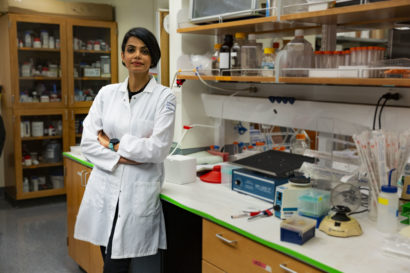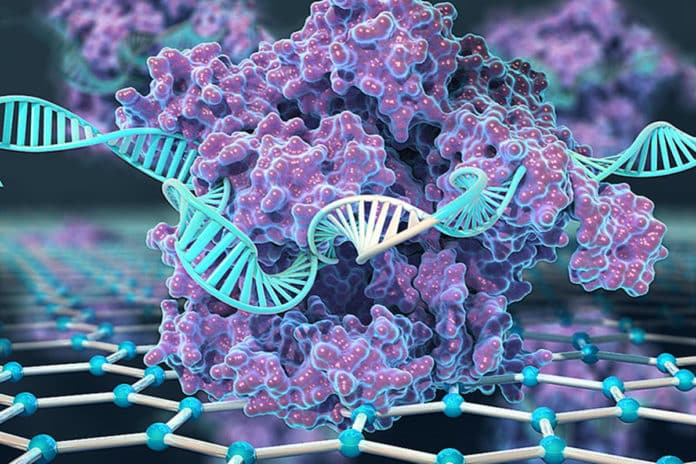CRISPR-Chip detect Genetic Mutations in minutes
The device uses CRISPR-Cas9 protein tethered to a graphene transistor
A group of engineers at the UC Berkeley, as well as the Keck Graduate Institute (KGI) of The Claremont Colleges, combined CRISPR with an electronic transistor made from graphene to produce a new hand-held device that can find genetic mutations in a matter of minutes.
This device called CRISPR-Chip might be utilized to quickly detect hereditary diseases or to assess the precision of gene-editing techniques. The team utilized the tool to identify genetic mutations in DNA samples from Duchenne muscular dystrophy individuals.
Kiana Aran, an assistant professor at KGI said that his research team has developed the first transistor that uses CRISPR to search the genome for any potential mutations. When a purified DNA sample is put on the chip, CRISPR do the search & the graphene transistor reports the search result in minutes.
Aran, who developed CRISPR-Chip technology detecting Genetic mutations, is the senior author of a paper describing this device that appears online March 25 in the Nature Biomedical Engineering journal.

Doctors, Researchers, and geneticists can now sequence DNA with this CRISPR-Chip technology to detect genetic mutations underlying
a host of traits and conditions. Companies like AncestryDNA and 23andMe even make these tests available to their curious consumers.But unlike most forms of genetic testing and recently developed CRISPR-based diagnostic techniques, new CRISPR-Chip uses nanoelectronics to detect gene mutations in DNA samples. The factor to be considered here is that this is done without first amplifying or replicating the DNA segment and an equipment-intensive process called polymerase chain reaction or PCR. This means CRISPR-Chip could be used to perform genetic testing in a doctor’s office or fieldwork setting without the need for sending a sample off to a lab.
Niren Murthy, the professor of bioengineering at UC Berkeley and co-author of the paper on CRISPR-Chip detecting genetic mutations said that this CRISPR-Chip has the benefit that it really points of care. And it is one of the few things where one could really do it at the bedside if one had a good DNA sample. Murthy added that ultimately, one just need to take a person’s cells, extract his/her DNA and mix it with the CRISPR-Chip and then they will be able to tell if a certain DNA sequence is there or not which could potentially lead to a true bedside assay for DNA.
The CRISPR-Cas9 system is famous for its ability to snip threads of DNA at specific locations. This is giving researchers unprecedented gene-editing capabilities. But the major problem faced by the researchers is that for the Cas9 protein to accurately cut and paste genes, Cas9 protein first has to locate the exact spots in the DNA that it needs to cut.
For Cas9 to detect a specific gene location on the genome, researchers must first equip it with a snippet of “guide RNA” i.e, a small piece of RNA whose bases are complementary to the interested DNA sequence. The bulky protein first unzips the ds DNA. Then it scans through until it finds the sequence that matches the guide RNA, and then latches on. CRISPR-Chip detects genetic mutations in minutes!
To harness CRISPR’s gene-targeting ability, the scientists took a deactivated Cas9 protein which is a variant of Cas9 that can find a precise location on DNA but doesn’t cut it. Scientists tethered it to transistors made of graphene. Whenever the CRISPR complex finds the spot on the DNA that it is targeting, the complex binds to that spot and triggers a change in the electrical conductance of the graphene. This will, in turn, change the electrical characteristics of the transistor. The changes can be detected with a hand-held device developed by the researcher’s industrial collaborators.
Graphene is built of a single atomic layer of carbon. It is electrically sensitive that it can detect a DNA sequence “hit” in a full-genome sample even without PCR amplification.
Aran said that Graphene’s super-sensitivity enabled them to detect the DNA searching activities of CRISPR. CRISPR brought the selectivity, & graphene transistors brought the sensitivity and, together, the team was able to do this PCR-free or amplification-free detection.

Aran and team hope to soon multiplex the CRISPR-Chip device by allowing doctors to plug in multiple guide RNAs at once to simultaneously to detect a number of genetic mutations in minutes.
Aran added that imagine a page with a lot of search boxes and in their case it was transistors. Imagine one has the guide RNA information in those search boxes, and each of those transistors will do the search and report the result electronically.
In order to demonstrate CRISPR-Chip technology sensitivity, the research team used the device to detect two common gene mutations in blood samples from Duchenne muscular dystrophy (DMD) patients.
Conboy, the co-author of the paper, says CRISPR-Chip technology could be an especially useful device for DMD screening. This is possible as the severe muscle-wasting disease can be caused by mutations throughout the massive dystrophin gene which is one of the longest in the human genome and spotting these mutations can be costly and time-consuming using PCR-based amplification and genetic testing.
Conboy, who also works on CRISPR-based treatments for DMD added that as a practice right now, the team who have DMD are typically not screened until it is known that something is wrong, and then they undergo a genetic confirmation.
He added that with a digital device, one could design guide RNAs throughout the whole dystrophin gene, and then one could just screen the entire sequence of the gene in a matter of hours. It could screen parents, or even newborns, for the presence or absence of dystrophin mutations. If the gene mutation is found, therapy could be started early, before the disease has actually developed.
Murthy said that rapid genetic testing could also be used to help doctors so that they can develop individualized treatment plans for their patients. For example, in a disease like Plavix where the genetic variations make some people unresponsive to expensive blood thinners. He added that if one has certain mutations or certain DNA sequences, that will very accurately predict how he/she will respond to certain drugs.
Aran said that as CRISPR-Chip detecting genetic mutations in minutes can also be used to monitor whether CRISPR binds to specific DNA sequences, it can also be used to test the effectiveness of CRISPR-based gene-editing techniques like this could be used to verify that guide RNA sequences are designed accurately. Combining modern nanoelectronics with modern biology opens new opportunities to get access to new biological information that was not accessible before, Aran added.
Source: UC Berkeley News































It is very nice, simple and easy to carry out to find out mutated genes and to design new one to enhance fields of research for patients betterment.